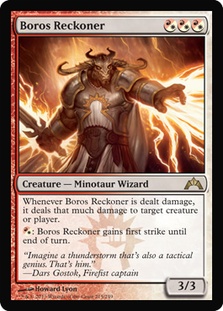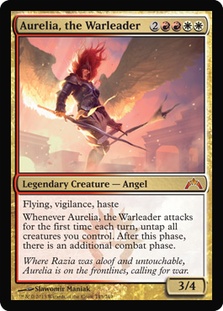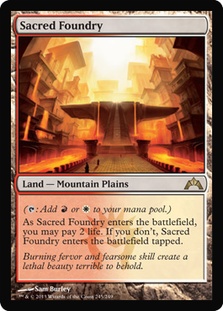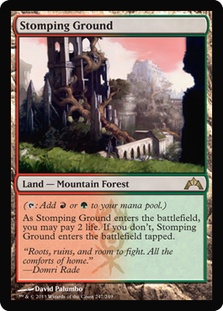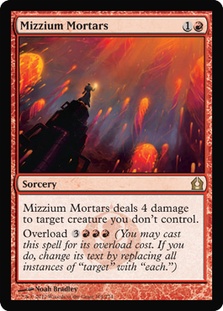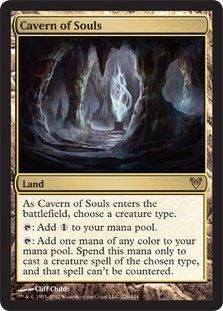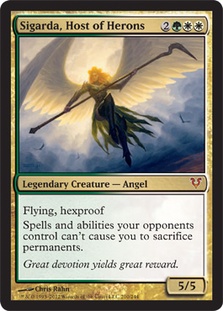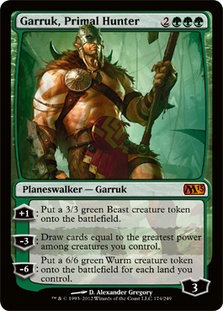I was not qualified for Pro Tour Gatecrash, but a bunch of my friends were. Isaac Egan and Adam Witton from Melbourne and Justin Cheung and Sasha Markovic from Sydney were all qualified. I consider Isaac and Adam to be two of my closest friends. As I mentioned in my previous article, I haven’t been playing a lot of Magic lately, but when Isaac said that he was counting on my help with his preparations, I couldn’t really say no.
As I do with all new formats, I started thinking of decks and possible interactions as soon as the new cards were spoiled. The addition of the remaining five shocklands was definitely going to spice things up, but I was sure that there would be some other juicy cards as well.
From the spoilers, the three cards that impressed me the most were Obzedat, Ghost Council, Aurelia, the Warleader, and Boros Reckoner. Obzedat seemed a little like Baneslayer Angel. When Baneslayer was first printed, everyone knew that it was good, but no one really knew which deck to slot it in. It didn’t fit in any existing deck, but its power seemed high enough to justify creating new decks. Obzedat is a lot harder to cast and doesn’t play defense anywhere near as well, but its protection from sorcery speed removal and the value you get just by resolving it made me think that it was of a similar power.
Boros Reckoner just seemed bonkers. Its prohibitive casting cost didn’t seem all that difficult, and its ability to shut down aggro as well at threaten midrange seemed unparalleled. Costing three made it clash with Loxodon Smiter and Silverblade Paladin, and I wasn’t sure at first whether it was maindeck good in white decks. It was definitely there for red decks.
Aurelia, the Warleader was the card that I was the most excited about. I just kept thinking about how easy it is to kill people on the turn that you cast it, how good it is against instant speed removal, and how well it plays with cards like Kessig Wolf Run and mana dorks. Just imagine: Thundermaw Hellkite, attack you for five; Aurelia, attack you for sixteen. This is the sort of thing I couldn’t get out of my head. It costs six to cast, which means you’ll want to accelerate into it. Since I’d played Naya all season leading up to Gatecrash, I thought it was the obvious first place to start testing.
Creatures (25)
- 2 Arbor Elf
- 4 Avacyn's Pilgrim
- 4 Huntmaster of the Fells
- 4 Restoration Angel
- 4 Thragtusk
- 1 Thundermaw Hellkite
- 3 Loxodon Smiter
- 3 Aurelia, the Warleader
Lands (23)
Spells (12)

This was my first attempt to update my Naya deck. Having access to the newer shocklands (Sacred Foundry and Stomping Ground) meant that you could play Arbor Elf and accelerate earlier and more often. With this in mind, I made the deck more aggressive. I replaced Garruk, Primal Hunter and Angel of Serenity with Loxodon Smiter and Aurelia, the Warleader.
The deck’s two biggest issues were Rakdos’s Return and Sphinx’s Revelation. Making the deck quicker seemed like a reasonable way to combat this, but I still expected these X spells to be a bit of an issue.
These were the other decks that I built early in testing:
Creatures (27)
- 4 Stromkirk Noble
- 4 Hellrider
- 4 Silverblade Paladin
- 4 Dryad Militant
- 3 Rakdos Cackler
- 4 Daring Skyjek
- 4 Wojek Halberdiers
Lands (23)
Spells (10)

Creatures (22)
- 4 Diregraf Ghoul
- 4 Gravecrawler
- 4 Geralf's Messenger
- 4 Restoration Angel
- 4 Knight of Infamy
- 2 Obzedat, Ghost Council
Planeswalkers (3)
Lands (23)
Spells (12)
Sideboard

The idea was to test these decks against the best decks that existed pre-Gatecrash to see if we had actually made any good decks and then update them as required. We didn’t get too far into the testing process before the first StarCityGames.com Standard Open results started pouring in. At this point, our priority was to test the decks from the Open as well as the standout in our early testing: Naya.
Other than testing with Isaac and Adam, I tried to combine our testing with the other Aussies who were qualified, including Justin and Sasha. The discussions were dominated by a testing group of one of the other qualified players, which meant that most of the contributions of ideas and results were from people who I did not personally know. Admittedly, I don’t really play that well with others in these kinds of situations, and after speaking to Isaac about this, we decided to just do our own thing.
Once again, we didn’t get that far into testing before Gatecrash became legal on Magic Online. Isaac and Adam both liked Naya a lot, so it seemed sensible to acquire online versions of those cards first. This meant buying three Aurelias. Isaac agreed to compensate me for the difference between the inflated Prerelease price of the card and the amount at which they finally settled. I accepted and got them just a few hours after the Prereleases had started.
From this point on, the three of us logged a bunch of hours playing in Standard tournaments on Magic Online. The feedback was overall quite positive, and it seemed that we had found our deck.
I had a couple of conversations with my housemate Jeremy Neeman about the general placement of deck. At the time (this was six days before the PT), aggro was everywhere. The natural progression would therefore be that midrange would dominate, and once that happened control would then dominate. I was worried that by the time the PT began, the format would be full of Sphinx’s Revelations and whatnot and that Naya would be terribly positioned. Jeremy was fairly confident that this would not be the case yet.
This is the list that Isaac took to a Top 25 finish:
Creatures (25)
- 2 Arbor Elf
- 4 Avacyn's Pilgrim
- 4 Huntmaster of the Fells
- 4 Restoration Angel
- 4 Thragtusk
- 4 Loxodon Smiter
- 3 Aurelia, the Warleader
Lands (23)
Spells (12)

As you can see, a couple of changes had been made since the initial testing list. Mizzium Mortars made its way into the maindeck, with a full playset post-board. The more we tested, the more we realized that playing four was a complete no-brainer. Whether you cast it or overloaded it, Mortars was a card that we wanted against all of the aggro decks and most of the midrange decks. The singleton Cavern of Souls was a concession to the third Forest not being able to cast Aurelia, as well as being generally fine in most draws. The rest of the maindeck remained virtually unchanged, but the sideboard turned out to be quite different.
The aggressive matchups were a bit of a joke and didn’t need much additional attention. That and there was very little to cut. The Aurelias were unnecessary in terms of winning the game and turned out to be a massive liability against Threaten-type effects. These three slots became the additional two Mizzium Mortars and Searing Spear. We were a little apprehensive about the Reanimator decks, and despite their recent drop in popularity, we still wanted access to Rest in Peace in the board.
The rest of the sideboard was dedicated to midrange and control matchups. Having six mana dorks proved a liability against sweepers, and replacing them with other mana sources was something I was keen to do. The Selesnya Keyrune was present in the deck pre-Gatecrash and was still good, while the additional land alternated between Kessig Wolf Run and Cavern of Souls a few times. I wasn’t actually sure which of these two the guys had settled on until after I saw their lists in the coverage.
Sigarda, Host of Herons and Garruk, Primal Hunter were the best go-late threats that I had found pre-Gatecrash, and they still are. They are still weak to Sphinx’s Revelation, so the plan is to just kill them before they get in excess of nine or ten mana. I’d flirted with the idea of "Reverberate, targeting your Sphinx’s Revelation" in the past, but without cards like Angel of Serenity, you are just really ill equipped in these sorts of long games. It hadn’t really been all that good before and seemed even worse now.
I feel good about the deck that I built, and I’m thrilled that Isaac managed a very respectable 7-3 with it. It was devastating to watch him lose playing for Top 8 on camera, but it was a great finish nonetheless.
Going forward, I’m not that sure how well Naya is positioned in the metagame. The most popular decks at the Pro Tour were playing Sphinx’s Revelation, and you certainly don’t want to play against any deck sporting three or more of these. If aggro and midrange are prevalent in your local meta, then I think Naya is the perfect choice. Formats evolve, and I can definitely see this deck being a great choice at some point down the line.
Another option is to throw a couple of Nevermores in the sideboard and just cross your fingers that they work. As a general rule, I hate cards like this, but given how much of a problem Revelation is, it might actually be a way to make the deck viable. If so, I would take out a Rest in Peace and a Sigarda, Host of Herons for them.
I hope you have enjoyed reading about helping my friends prepare for Pro Tour Gatecrash, and I look forward to your comments and feedback.
Dan Unwin
Sledgesliver on Magic Online


